#screenplay pattern
Explore tagged Tumblr posts
Text
Man I desperately yearn for feeling appreciated as a creator
#i want to post the screenplay i wrote today but also like#i spent weeks on a drawing that flopped#and that one fic I wrote weeks ago still only has 28 hits and 0 comments#and its like fine im not trying to guilt trip anyone#Im just having some emotions while looking at different communities and patterns in how people interact with each other#i want to feel like that too
4 notes
·
View notes
Text
Playwriting
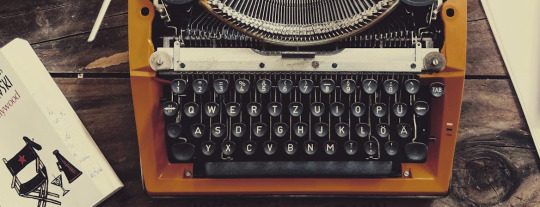
Playwriting - the art of crafting a dramatized narrative for a theater production.
Much like a screenwriter drafts screenplays for television and film, playwrights compose playscripts for characters to perform live on stage in front of an audience.
Whether the artist chooses to write a full-length play or a powerfully concise one-act piece, this type of dramatic writing affords a great degree of creative freedom.
How to Write a Play
Whether your goal is to take your creative writing skills to Broadway or put on a performance for friends and family, you can use the following steps to pen your masterpiece:
Determine your story. Brainstorm a few ideas that translate to the stage. Consider the message of your play, and invent a central conflict that underscores what you want to say. Everything in your narrative will happen live on stage, so keep production elements like space and special effects in mind. If you have a complex or surreal concept, think of a creative way to represent it physically. Read other plays by famous dramatists, such as Shakespeare, Henrik Ibsen, Samuel Beckett, David Mamet, Arthur Miller, and Tennessee Williams, to draw inspiration, set the pacing, or even help determine the scope of your own world.
Determine the main character. Stage plays are largely character-driven stories. Believable fictional characters are unique, relatable, and three-dimensional. A character’s motivations inform their actions and decisions, creating the narrative arc in the story. Identify the protagonist (the main character) and their goals, traits, and backstory. Craft a compelling antagonist to bring conflict to the main character or supporting characters. Avoid tropes or clichés when crafting your main characters, which can turn an audience off. Turn to classic archetypes to invent characters who will bring the best (and worst) out of one another.
Outline your idea. Begin outlining your play by separating it into acts. Common structures include the one-act play (which is very short), the three-act play, or the five-act play. Write down the beginning, middle, and end of your play, including major story beats and plot points surrounding your main conflict. Separate your plot points into their respective acts, following a pattern of rising action (leading up to the climax) and falling action (leading up to the resolution). Keep your act breaks compelling to maintain the audience’s interest. Include a subplot or two that helps to develop your characters.
Input stage directions. Consider stage movement when drafting your playscript. Include stage directions (such as entering and exiting the stage) and any physical actions necessary to the storyline or character development. Actors need the freedom to embody the character in their own way, so don’t get overly specific with movement description. Note important elements about set design, lighting, or props. Leave time between scenes for technical elements such as scene changes or costume changes. If your play is longer than one act, include an intermission so that your audience members have a break to stretch their legs and refresh their minds.
Write your acts. Once you break out your narrative arc, flesh out the body and action of the play. Write the play out of order if it helps with your creative flow. Some writers start writing the climax or end of the play before the first act to help them avoid overwriting and to ensure that the story stays on track. Each act should contain its own arc within the larger narrative, always highlighting the play’s theme and message. Break long scenes of dialogue up with action, tension, or surprise.
Use proper formatting. Like writing for the screen, scriptwriting for the stage follows specific formatting conventions. Format your play correctly to ensure it is easy to read and looks professional. Most playscripts center and capitalize the character names on the page; indent and italicize stage directions; and center act and scene headings in all capitals. When in doubt, use script-writing software, which will automatically format your playscript and remove any guesswork.
Reread and revise. After completing your first draft, read through the entire play from beginning to end. Jot down any notes for yourself in the margins, then reread the script with these insights in mind. Check for inconsistencies (such as continuity or timeline issues), plot holes, or weak character dialogue. Ensure that the characters’ actions and behaviors align with their motivation, and tweak as necessary.
Proofread and edit again. Using the notes from your draft, take a second pass at your script. Fine-tune the dialogue and the action. Commission family and friends to read the script and provide honest feedback.
Do a table read. Ask some willing participants to volunteer for a table read, which is an organized script reading in which actors and producers read out the dialogue, stage directions, and scene headings of your play. The table read will highlight elements of your play that you might need to tweak. Pay attention to each line of dialogue and how the action flows. Apply the learnings from the table read to the final draft of your script.
Source ⚜ More: References ⚜ Writing Resources PDFs
#playwriting#writeblr#literature#writers on tumblr#writing reference#dark academia#spilled ink#writing prompt#creative writing#writing notes#writing tips#writing advice#light academia#writing inspiration#writing ideas#writing resources
85 notes
·
View notes
Text
A thing I really enjoy about RGU is how when producing the anime the crew was aware of the budget and limits that often come with TV shows at that time and created their own cinematographic language based on them.
The roses, the frames, the transformation sequences... Not only were they able to use them smartly but also make them reinforce the core themes of the show; that of repetition, circularity, a repeated movement, a revolution.
I personally greatly appreciate when narrative media is -meta- not in a direct way but in its semiotics. Utena creates this language based on repetition and is constantly seen subverting it, adding new "rules".
Episode 33 is cinematographicaly one of the episodes I find most interesting because they literally put the turning point of the story (I personally think of this episode as a turning point because we see Utena finally with her "prince"; except that, instead of the happy "ending" one would expect in traditional stories, it is here where everything comes into place and the grim reality is made perfectly aware. Were Utena a traditional princess story, episode 33 would mark a happy conclusion. Instead it is only the beggining of what lies inside the box and once opened it cannot be closed again) in an episode that is all about repetition. A recap.
Also, for as much as many people gloss over the Black Rose Arc I very much think it crucial to establish all of RGU's symbols. Because Utena doesn't tell us things, it wants us to learn them by noticing the patterns, by seeing the repetitions and where they are being broken, so that we ask ourselves why. The elevator sequence is one of such cases where we learn more of the characterization of these characters by seeing how they act inside of it. It's even a basic screenplay exercise: "how would your characters act trapped inside an elevator".
Mikage itself is a shadow, not just of himself but of Utena as well, an omen forever frozen in time.
Because that's another theme, shadows. And how in a way they are echoes, simplified and distorted repetitions of oneself.
And while shadows are cast in contrast, projections are cast forward. While one is a memory of something, projections are the reproduced illusion of it.
Utena works with parallels and repetitions and understanding their semantics and syntax allows us, the viewers, even subconsciously to feel their weight.
#just wanted to leave some of my thoughts out there althought these are clearly unorganized and probably on closer revision wont make sense#regarding shadows and projections we can also talk about the construction of self and how that ties to the theme of growing up and maturing#like I sair rgu has this whole narrative language that in closer inspection is just so brilliant#rgu#utena#meta#utena meta#revolutionary girl utena#analysis
175 notes
·
View notes
Text


“It's for a comic strip I do called 'Grumble and Bumble,' Grumble likes to yell but deep down he loves Bumble like a son.”
Seymour sometimes has a creative side, whether it be accidentally plagiarizing Jurassic Park for a book he's been thinking about writing (s5 ep19) or writing a couple screenplays in the hopes of getting them to Universal Studios and winning an Oscar (s19 ep18), and likely due to a lack of an active imagination or minimal media consumption he tends to draw inspiration from his own life for his art.
The screenplays he wrote in Any Given Sundance had titles that he fairly obviously based on his life or desires - “When Edna Met Seymour” (this is 4 whole seasons after they broke up), “Ghost Willie” (Willie hates Seymour's guts like most of the school staff but how much Seymour hates him back I can't quite say, or this could be more metaphorical and Willie's hatred is manifested into a threatening ghost form), “Killing Seymour's Mother” (he's expressed a desire to kill Agnes multiple times throughout the show due to resentment and despite his seemingly unconditional love for her), and “The Principal Who Sold a Screenplay” (this is simply premature wish-fulfillment)
“Grumble and Bumble” is no different. If the designs of the characters didn't make this obvious enough, Grumble is Chalmers and Bumble is Skinner himself, and thusly he is speaking indirectly about his ideas of what his dynamic with his superintendent is by using Grumble and Bumble as an allegory. But why would Seymour believe that despite the sometimes abusive tendencies Gary treats him with, Gary loves him "like a son" deep down?
I've often thought how similar Chalmers is to Agnes in some respects, especially when it pertains to their treatment of Seymour, but to an audience they have their fairly obvious differences.
While Agnes' abuse stems from a mix of bitterness and a fear of abandonment from the only person who still loves her despite her behavior, Gary's abuse seems to stem from a deep-seated annoyance with Skinner's behavior. Chalmers doesn't like Skinner being his bootlicker, the few times Chalmers treats him with benevolence or fondness is when Skinner acts confident in himself, unburdened by Chalmers' whims over him, meanwhile Agnes actively kicks him down when he tries to stand up.
Of course, it doesn't really make a difference to Skinner, I doubt he himself sees the difference, all he knows is that they dislike him but he can sometimes win over their affection if he does... Something, anything, likely whatever they want him to do which is be obedient and successful at his tasks despite his nightmarish circumstances because that's what they yell at him to do. He can't differentiate between what Chalmers likes and what Agnes likes because he's so used to his mother and Chalmers is so close to that pattern of behavior they might as well be the same.
And just as Seymour loves Agnes, he also loves Chalmers. It doesn't particularly matter if that love is familial or platonic or even romantic on Seymour's end, really, because it all leads to the same result; that love leads to a desire to fulfill whatever harsh demand is given to him. He's a dog in that sense, and he never knows when to quit (as Bart says; "No matter how badly you get treated, you always come back for more! It's like your superpower!" - s32 ep8).
And despite everything Gary's put him through, he hopes desperately that he can achieve and continue to maintain any morsel of affection he may throw for doing a good job, just like Agnes would. He thinks the abuse hides an inherent affection Chalmers harbors for him; why else would Gary keep coming to school to see him? Why else would he seem to care about it so much? It must be similar to how his mother still keeps a roof over his head or cooks him food; she cares despite her hatred, because he is her son and there's an unconditional love there between them. Seymour knows this, and so therefore there has to be one conclusion, no matter what kind of affection Skinner feels for him:
Chalmers likes to yell but deep down he loves Skinner like a son. Just as Agnes loves him as a son.


“No he doesn't.”
— s26 ep11, Bart's New Friend
#the simpsons#simpsons screenshot#seymour skinner#principal skinner#gary chalmers#superintendent chalmers#should I tag this as a ship..#chalmskinn#character analysis#reading too much into Simpsons jokes is my specialty <33
62 notes
·
View notes
Text
Here in the end times, it feels like everyone got a little weird.
That'll happen, you know? In a city of bondage rooftop pirates, predatory psychic business suits, and tacticool kindness cults; in a world where the sun's gone all high contrast, low brightness; in a time where isolation is a synonym for safety ... let's just say the 'Overton Window of Normality' has shifted.
Yep, when the light broke, we all got a bit strange.
All except for Simon, that is.
Simon is perfectly normal. Simon is swell. Simon still stops by Nero's for a coffee in the mornings and the Coffee Mafia *serve him* (I think just out of confusion).
Simon goes into his co-working space three days a week. Sometimes he works on his screenplay. Other times he goes through long-dead databases and de-duplicates records. If you ask him why, he'll just say that he gets tired of working from home all the time and needs a change of scenery.
Simon keeps a spreadsheet to track the good places for salvage in London-in-Darkness. He has different tabs for foodstuffs, fuel, clothes, makeshift weaponry, and a dozen other useful categories. He sorts them according to quality, abundance, known predators, level of contrast corruption, and convenience for his commute. Ask him to show you his v-lookups sometime.
If you haunt the high buildings like I do, then you'll see him sometimes, scuttling about in his scruffy converse, jeans and hoodie. If he sees you see him, he'll wave.
It's not that the various predators, gangs and high-contrast memetic hazards avoid him, exactly. They continue their usual routes; their patterns of search, destroy and throw-a-wobbly. But somehow they just ... miss him. He'll be overlooked or have a miraculous lucky escape. Occasionally, he'll get captured for a few days and spend the time working on his yoga routine, before the next localised burst of spectrum distortion gives him a chance to scarper.
You might be tempted, if you run across him, to join Simon.
You might hear him say things like: "Why don't we pool our resources" or "Let's catch up sometime" or "I've set up a mini golf course in the Tate Modern, if you fancy it" or "Do you want to listen to some Bruno Mars? I think I have one of the last unscratched CDs."
I urge you: do not listen to him.
He means you no ill will. Simon is *normal* and *nice*.
But nice is not kind. Normal is not benevolent. And sometimes, people overlook that the world will hurt those less lucky than them without really thinking about it. And it is *normal* to protect yourself in that way. It is *nice* to gloss over difficult things.
Simon lives a live that is orthogonal to the rest of us. His plane of existence is ever so slightly out of sync.
Yours isn't.
He is a last unchanging remnant of a world that was.
You aren't.
If you meet him, you will want to follow him. His is a world of order and predictability, of self-care days and flexi-time, of secret film screenings and hidden menus in bougie coffee shops. You will be enchanted by the way he talks about getting plenty of natural light, the way he complains about his commute, and how he still tips twelve percent.
But I beg you: do not heed his Simon song. For it is the song of Bruno Mars and you will be dashed on the funk rocks.
Don't go with him, the world that keeps him safe does not exist anymore.
And when I see Simon scuttling through the streets with a new friend, I am sometimes glad that it is gone.
93 notes
·
View notes
Text
Thank you for the tag, lovely @crepesuzette2023! It's been nice to take some time to think about my fics!
How many works do you have on ao3?
20; 18 are Johnlock (BBC) and two, the most recent ones, are mclennon.
What’s your total word count?
306,378 (I was stunned to see this, I had no idea).
What are your top 5 fics by kudos?
All are Johnlock: Mark Your Calendars, my beloved Erosion, Detours, Plus One and Turned - Part I : Queen and Country.
Do you respond to comments? Why/why not?
I try to be very good about it and respond as often as I can, but the truth is I'm a bit of an emotional wreck so when there's a rush of comments I get overwhelmed and over emotional about them, and tend to put it off for a while. I read them ALL, and I often go back and re-read them.
What's the fic you've written with the angstiest ending?
I had to refresh my memory but it's def Every Other Universe ("What if in every other universe John Watson leaves?"). It's one of my very earliest ones and I cringe a little reading it, but it's a very neat idea. Gretna Green Waltz, a mclennon fic, is very devastating if I may say so myself, and was written as such knowingly. It only reflects reality, though, and that's just as devastating.
What's the fic you've written with the happiest ending?
I think Mark Your Calendars has the happiest ending, judging by the numbers of kudos, but for me as the writer, the cosiest, most joy-bringing ending was that of Simon (or: Love Calls You by Your Name).
Do you write crossovers?
The sadly abandoned Turned series is a crossover with Homeland.
Have you ever received hate on a fic?
Not hate, but some less-than-considerate "when's the next chapter???" comments. I don't bother with them.
Do you write smut? If so, what kind?
Yes I do :)
Have you ever had a fic stolen?
Don't think so!
Have you ever had a fic translated?
I remember being asked, but I'm not sure what happened with it! Some of my fics got podficced, though: Mark Your Calendars is available as podfic, and so is I Have not Lingered (thanks to the lovely @helloliriels)
Have you ever co-written a fic before?
No, I'm so neurotic and particular I don't think I'm cut out for that.
What's your all-time favourite ship?
Mulder and Scully are DEFINITELY the mothership and always will be. I still sigh about them in a special, exasperated way about three times a week. I'm still here with Johnlock of course, but I'm pretty sure mclennon has been in the back of my mind for decades, but I was too haunted by other ships to fall down that rabbit hole. Look at me, though, here I am.
What's a WIP that you want to finish but don't think you ever will?
Turned, very sadly. So much so that I've considered taking it off AO3 but I'm so proud of what I did achieve with it.
What are your writing strengths?
I think my best writing moments are the ones that hook unto my real, personal experiences, not just a general idea of life situations. Erosion is based on my own personal grief and family losses, and Gretna Green Waltz is a retelling of my biggest heartache. I have noticed readers can tell when you're really putting your heart into a story.
What are your writing weaknesses?
English isn't my first language, which means I have to rely on betas which for me sadly slows me down - I want to be able to just write them and post them otherwise I overthink. I'm also a screenwriter irl, and I noticed a pattern that is another weakness - I always have banger openings, or first acts to my stories/screenplays, but sometimes I don't know the ending and I get lost and hesitant. That's why Gretna Green Waltz was SUCH a surprise - much like Junk, the song that haunts Paul throughout the fic, came to him in one piece, GGW landed in my head as a full story. I wrote it in TWO WEEKS! That NEVER happened before!
What are your thoughts on writing dialogue in other languages in a fic?
It really depends on how it's done. If it's 2-3 sentences and they're simple I assume the readers will Google Translate it. Jinglebell stands out as someone who did it really well in multi-chapter fic that's all about Sherlock discovering that John is a polyglot, so it can be done well.
What was the first fandom you wrote for?
Johnlock (for which I started writing during covid in 2020), although as a reader it was TXF, back in in 90s and early 2000s.
What's a fandom/ship you haven't written for yet but want to?
The X-Files. I've had a Scully character study in my head for years that I just can't get right.
What's your favourite fic you've written?
With Johnlock it would have to be the now-abandoned Turned, and mclennon it would be Gretna Green Waltz. I am very proud of both.
Tagging @menlove, @discordantwords, @saint-mona, @totallysilvergirl @m1ssunderstanding @slippinmickeys @kettykika78 @agrlsname @arwamachine @calaisreno @aggressivewhenstartled and anyone who sees this who wants to participate :)
26 notes
·
View notes
Text
Struggling with writing dialogue? Here are 5 ways to strengthen those chops!

I've won a couple awards for my plays so trust that I know what I'm talking about
Write a script! No, seriously. Take out the whole concept of prose and write a script. Whether it's a stage play or screenplay, it doesn't matter. Of course, you might have some opportunities for prose writing with stage directions, but the beauty of a script is that you're telling a lot of the story through dialogue and slight direction. You'll learn REAL quick!
Watch TV shows and movies and really pay attention to the dialogue! The next time you binge-watch your favorite TV show or have a marathon of your favorite movie series, pay really close attention to how the characters talk. What vocal tics can you point out? Do their speaking cadences sound natural? Was there a line that made you cringe because it sounded forced? Make note of what you like and don't like and keep it in mind for your own writing!
READ! A LOT! This feels like a no-brainer, but I'm including it anyway. Read some books by your favorite authors and make note of how they write their dialogue. Does it read naturally to you? Did something give you an unwanted flashback to your FFN reading days? What do they do to make dialogue distinctive between each character? Make note of it for future reference!
Listen to everyday conversation! Don't play coy, I know you're a little eavesdropper sometimes. Use that eavesdropping to your writing betterment and really listen to how people speak to one another. How does that Karen screaming at the poor Starbucks barista emphasize that her order is wrong? How does the barista tell her to go fuck herself without ever saying those exact words? These studies can prove integral to helping you master your craft of dialogue writing.
Keep a quote book! Saving the best for last, because I do this one myself and its proven the most helpful. I keep a quote book of all the notable things my friends say and use it as a reference point for writing different vocal cadences, speech patterns, and have even used some of them as springboards for writing scenes! You really can't go wrong.
As always, happy writing! <3
#writer#writers#writers on tumblr#writing#creative writing#writers and poets#writeblr#writerscommunity#on writing#writing community#writing help#character writing help#writing advice#how to write#fiction writing#writing tips#writing resources#writing dialogue#dialogue ideas#character dialogue#creative writer#creative process#creative
44 notes
·
View notes
Text
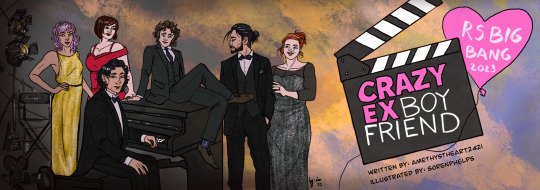
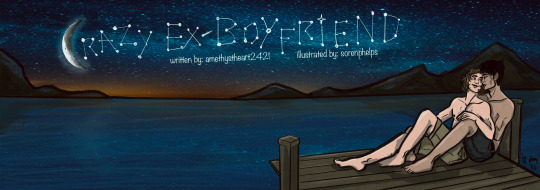
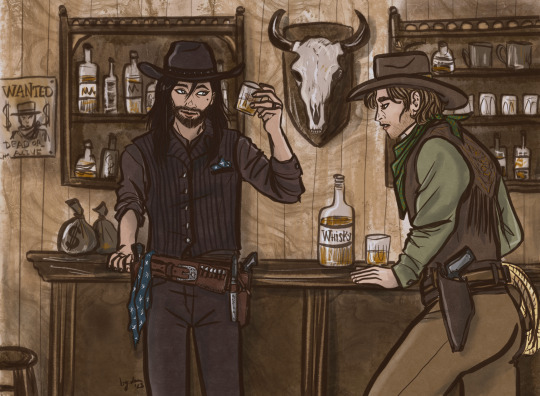
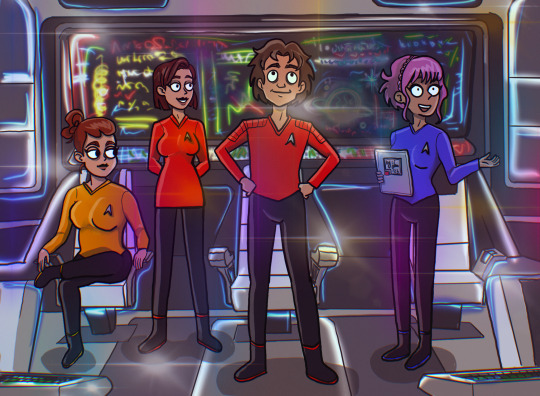
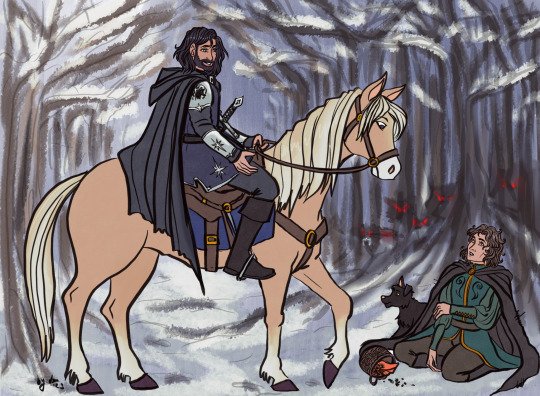
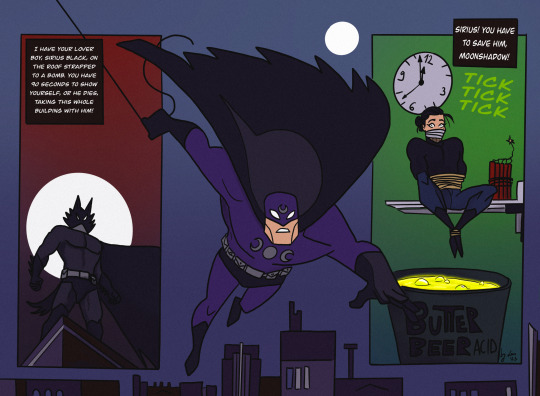

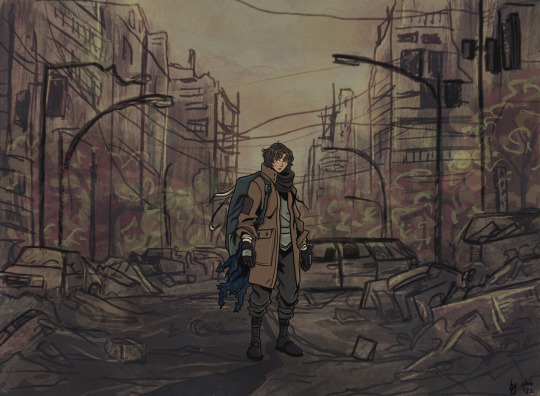
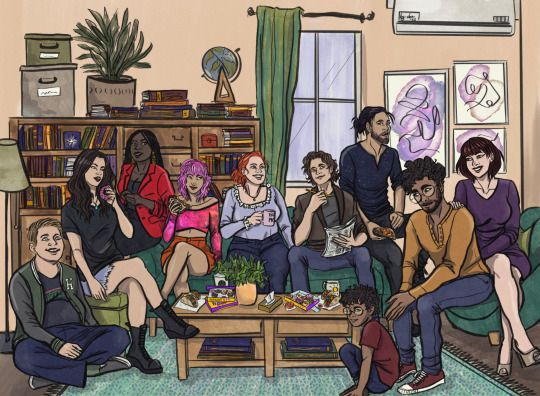
All the artwork I made for the fanfic Crazy Ex-Boyfriend by @amethystheart2421 for this year's @rsbigbang!
It was a wild run, we got paired up quite late due to our original pairs dropping out of the Bang, and even though it was already December and time was running thin, I decided to make this whole deal a way bigger challenge than it supposed to be... So I ended up drawing all 7 fantasy sequences, trying to mimic a different style for all of them, and finishing both versions of the banners I had in mind. I know, I know, but I swear even I wasn't aware that I am such an overachiever either!
Also, I usually like to hide little details as easter eggs on all of my artwork, so naturally this was the case with these too. I'm gonna list them one by one, also share a little story about each piece, sort of like a "directors cut werk", just so we stick to the screenplay motif. The numbers in brackets lists the order in which I drew the pictures.
The banners (1.,9.): I haven't watched Crazy Ex-Girlfriend the show, so I really had no idea about this whole thing, hence my initial idea of re-drawing one of the official promo posters of the show as the banner. But then Nicole shared the first scene with me when we got paired up, and also told me that her original artist wanted to draw the stargazing scene, which I also really liked. I sketched out both versions to see which one would look better, and also to warm up a bit for this version of the characters. (Nicole also shared some faceclaims, so except Sirius' and Lily's design, I tried to stick to her vision as much as I could.) The Netflix poster was considered the final one for quite a while. The stargazing banner was the last piece of artwork I finished, which I also edited to be used as Chapter dividers. I liked the idea so much I actually referenced the starry sky on the other pictures too. On the Netflix banner, Remus' socks and Sirius' suit handkerchief (how do you call those things in English, gahh) both have the starry pattern.
The western (3.): By this time it was decided that I'd do all fantasy sequences in a different art style, but I couldn't really come up with any specific style which could have fit the western vibes, so the characters are drawn in my own usual style, only the colouring is different. I tried to go for a sepia effect, without using a filter, I think I could pull it off well enough. I was considering to draw Sirius as a Native American for this, because I just don't see him as Caucasian in general, and also, Black Dog sounds like a badly translated indigenous name... But I discarded this idea for the sake of "historical accuracy" (and to save time, haha), as I think they wouldn't visit a saloon this way. I added the starry sky pattern to Sirius' handkerchief and... scarf? (I really should learn how certain textil items are called in English...) There is a wanted poster in the background with Voldy. And I swear I didn't mean to draw Remus looking this horny, it just kinda happened by accident! He is sure VERY fascinated by Sirius'... pistol.😜
The Star Trek (6.): My original idea was to draw like usual and just add so many lensflares to the picture that it's not visible if I copied another style or not. But in the meantime I started to watch Star Trek: Strange New Worlds with my bf and also found out that there is a new cartoon too, so it was then settled. This style is very different from my own, but it was so much fun! It was weird not to draw every single strand of hair in excruciating detail, actually that was the hardest part, haha! I struggled a bit with the placement of the lensflares too, the first version had too many and too bright, it had a disco vibe rather than a spaceship. I wanted to add easter eggs to the background screen, but I was running out of time, so there's only one light blue star similar on the screen! Also now I know that the uniform colors are not really consistent in Star Trek, and Remus’ might have had to be gold as Captain…🤷🏻♀️
The Disney (2.): This one sparked the first idea in my head after I read all fantasy scenes Nicole kindly shared with me. When I first sketched this, I still had no idea that I will end up drawing for every chapter and the style copying was not settled either. It started with this piece, I had the vision of the wolf chasing scene from Beauty and the Beast, and we were discussing whether it's plausible to collect berries during the winter or not... I've tried to make the final piece look as classic Disney as I can, and since I could pull it off, it was not a question anymore whether I'd try to do this with other styles for the other scenes. Retrospectively, this one was the easiest to make, apparently my usual style is not that far from Disney (I grew up watching those movies, so it's not a surprise), but I had to really focus on drawing the animals, it's been ages since I last drew any! (The trick is to give them eyebrows, and bam, it's Disney style!) Sirius' armour, clothes and sword has the star, and I also designed his own "crest" with the black dog and a star on his shoulder plate. The whole concept of the picture is Sirius' side being very bright coloured, while Remus' with the scary wolves in the background being very dark. This might have worked better if it was not set in the winter, but I wanted to stick to the Beauty and the Beast vision I had.
The Comicbook (4.): I was very excited for this one, I really like the looks of the old Batman the animated series, and the way some of his comics are drawn. It's such a unique style, I really like the simple shapes and bold contrasts. Well, it turned out I am very bad at this! I struggled quite a bit trying to capture what I had in mind, but I couldn't even come close to it... So I kinda cheated a bit because I just traced the lineart directly from the reference pictures of Batman comic books I found online. I tried to make Remus less buff, but it looked very weird, so I let him keep his muscular Batman body instead. I drew the wolf mask and the whole Sirius panel, and the coloring went smoothly after I finalized the lineart, even though I only realized that I switched the colour schemes of Remus' superhero outfit when I looked up the quotes for the comic panels, oops. Overall I like how it looks, but I am not that proud of it as I had to "cheat".
The Hobbit (5.): I've probably spent the most time with this one! I actually really like Martin Freeman as an older Remus FC, so I was quite excited to do this piece. My original idea was to mimic John Howe's style, as he is the Tolkien illustrator god, but his level of skill and mine are very very far from each other... and as I struggled a lot with the Batman piece, I felt like going for a smaller challenge. That's why I decided to have a go at Alphonse Mucha's art nouveau style. Turned out it was the worst possible idea! 🤣 The whole point of art nouveau is depicting attractive ladies in an ethereal way... But if you switch the ladies with a fat hobbit, the vibe def won't be the same! The first version just looks so extremely absurd, it's both awful and hilarious. By the time I could fix the pose so it wouldn't look as ridiculous, the final style looked nothing like art nouveau... I still have no idea what style it is now, not my own or any of the ones I tried to capture, that's for sure. I considered adding the star pattern to that tablecloth, but I decided that the lupin flowers in the foreground and the whomping willow-like tree are enough reference for this pic! I like how it turned out in the end tho, I think I could do justice for the watercolor-looking coloring technique, and the end result looks a bit like a fancier version of old children's book illustrations... Which is essentially what The Hobbit is, so it all sorted itself out by the end.
The Anime (7.): I like anime (I'm a little picky about them tho), so it was not a question that I would give this style a try! I am a huge fan of cyberpunk (the genre), so initially wanted to do that, I'm such a slut for Ghost in the Shell and I really like the aesthetics of the Akira posters, but after reading the actual scene, it was not really fitting. So I saved the cyberpunk AU for later, and went for the post-apocalyptic vibe instead. Obviously anime had a great influence on my art style, so similar to the Disney one, it was not that much of a challenge to mimic it. However I'm not that good at drawing backgrounds, and oh boy, I really made myself get over this obstacle with this series of pictures! Also as I was more comfortable with this piece, I actually added the starry sky pattern from the beginning to the scarf/blanket Remus has on this picture!
The Sitcom (8.): The original idea was to copy Hanna Barbera's old family cartoons' style, but as my deadline was very close and after reading the scene I realized that it will have a shitton of characters, I quickly abandoned my original plan. So this one is drawn in my own style, sort of, the designs of the characters are more aligned with Nicole's vision (sans Sirius, Lily, and partly Peter). The hardest part was definitely to figure out how I could fit 10 characters into one picture, let alone sitting in a living room! Also, I had to actually draw the living room too, considering perspective and scaling... Something I am not that good at. In the end the coffee table is maybe a little too big, but I needed that to hide the legs of the characters sitting on the sofa, haha! Also, the sofa is the Millennial Dark Green Velvet Sofa, because I also want to have one and it really emphasizes the general existential dread! (Just kidding.) Also also, I just realized that I have no idea how to eat tacos without making a mess (they are not that popular where I live). I added the starry sky pattern to Sirius' shirt, and gave a Teenage Mutant Ninja Turtles T-shirt to Peter, as he is talking about that in the scene. I wanted to squeeze in further references to the newspaper Remus is holding, but it was too tiny. The star from Knight Sirius' armour is in the background on the bookshelf. Also that globe just makes no sense but I had no better idea how to fill the empty space 😅. Molly is holding a mug with "BEST MOM" written on it, and I intentionally made Marlene's eye colour the same as Remus', who btw should have worn a bathrobe according to the original scene, but it was too late to fix that by the time I realized it. All in all, I am quite satisfied with how it turned out, it has the necessary sitcom vibes. And it is kinda a record for me in terms of number of characters drawn (the most was 12, but that one has no background, so I'd call it a tie!)!! I am very proud of myself for pulling this piece off, it really is the achievement of the year!
TLDR; (I mean really, my rambling is just too long!) I am happy that I was paired up with Nicole, working with her was such a creative process! My absolute favourite thing to do is work on AUs, and she has provided me with the opportunity to do so, I am grateful! It was truly a pleasure to participate in this (even if it's not that clear from all the complaining I just had above, haha)! If you ask me nicely I might show you the cursed first version of the hobbit picture!
#r/s big bang#wolfstar#sirius black#remus lupin#regulus black#james potter#lily evans#nymphadora tonks#molly weasley#peter pettigrew#harry potter#marlene mckinnon#dorcas meadowes#crazy ex girlfriend#lotr au#cowboy au#disney au#star trek au#anime au#sitcom au#batman au#fanart#art by lau#lau draws with a tablet#collaboration#marauders#amethystheart2421
73 notes
·
View notes
Note
I'm gracing you inbox again, Pet, because I saw colours and of course thought of you...
Ploy's Yearbook finished this week and whilst I don't think it was necessarily colour-coded (there are a lot of characters and I didn't put much effort into tracking visual patterns) I wanted to share this moment of deliciousness at the end:
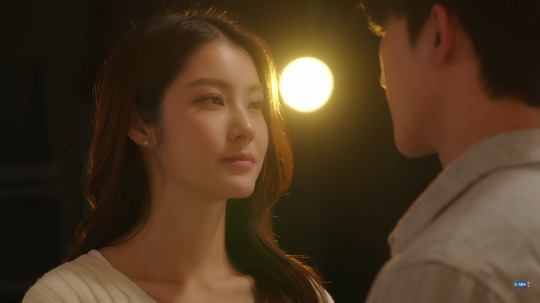
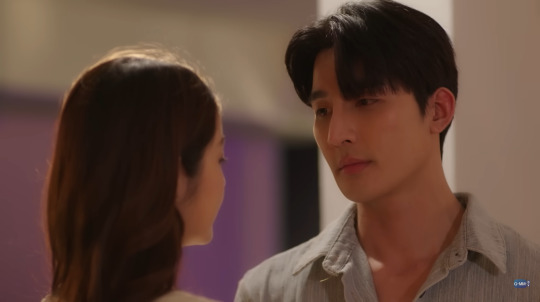
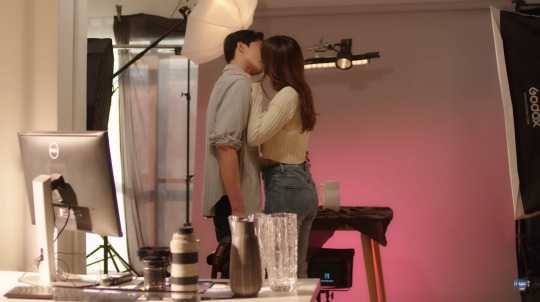
Do you see it? I'm sure you see it... (the blinding light of yellow love and the deep purple and the piiiiiiink 😍).
Anyway, the series was a generally okay het offering which mostly showed that the women at GMMTV need more opportunities to shine. But what it did do very well was the period representation (like, actual talk of bleeding), Joong looking like a whole-ass meal in the last scene (seriously, I think you'll want to go see that, it's a bit too blurry to screenshot), and the woman popping the question for once! (oops 🤭 spoilers, I guess).
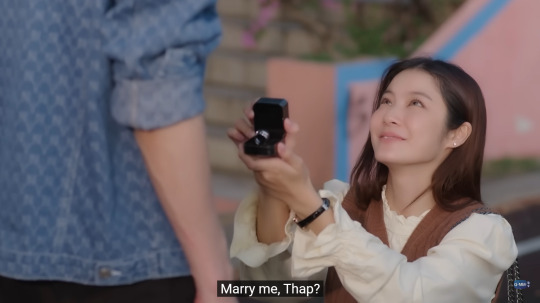
#I wish there was a way of adding tags to an ask #so that I could leave a sort of post script ramble #maybe this will have to do #there isn't really any point to this ask #just that I wanted to say hi and that I thought of you #💛💙
*warning* This is going to turn into a
Cupid's Last Wish Appreciation Post
"Do you see it? I'm sure you see it…"
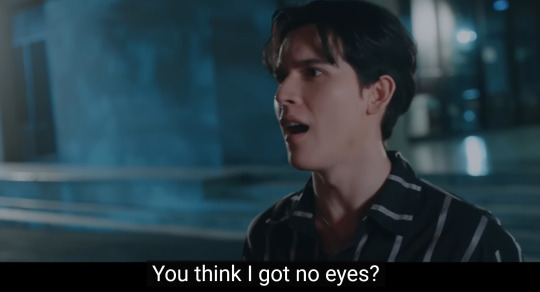
I thought twice about using the above image because it comes across a bit hostile, but any chance I get to insert a Big Dragon moment into the conversation, I'm taking it! Also . . .
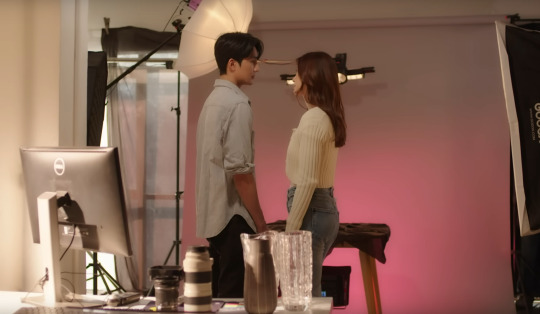
Hopefully, we ALLLLLL see that pink = 💕love💕even when it's for the het couple (when the only het couple I've ever cheered for was this one, which oddly enough, also included Namtan).
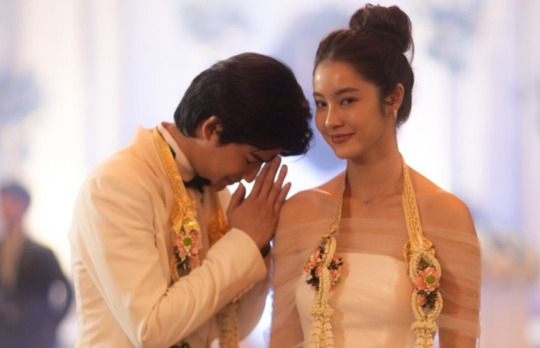
So maybe I'm just really rooting for Namtan and the other ladies because I'm already seated for her and Film to hit me with that Blinding Light of Love in Pluto.
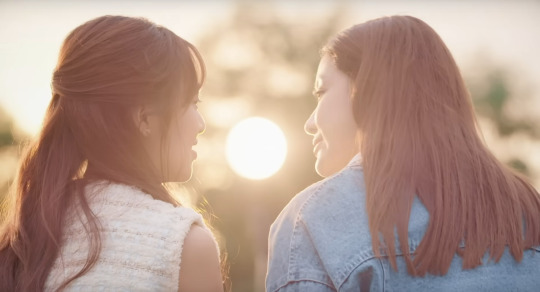
You already know that I agree with you that GMMTV underutilizes its women, but since I gave Namtan some love, let me turn to Earth while I give some love to Cupid's Last Wish for having good period-rep as Korn clutched every kind of tampon and pad
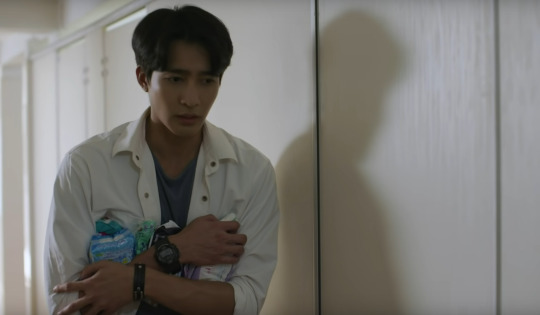
For his body-swapping not-yet-boyfriend!
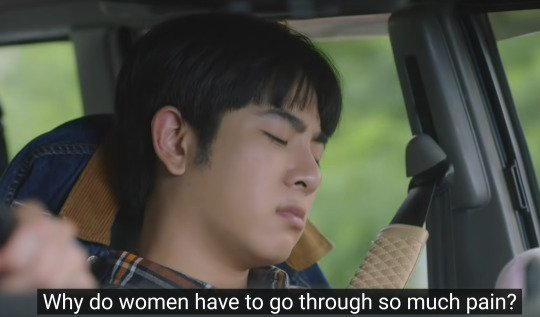
And not only did the man buy all the pads and tampons, he bought pain relievers and chocolate based on the staff's recommendations. THEN, he gave his guy a warm water bottle to help with his cramps and held him all night!
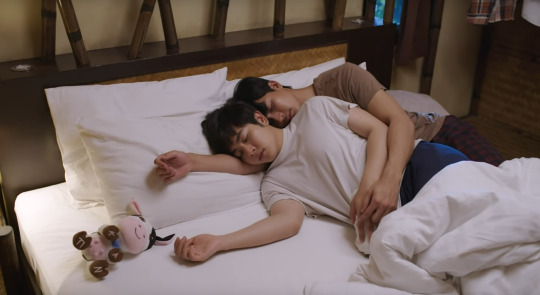
And that as AFTER he hugged his man when he was having a breakdown about his body betraying him.
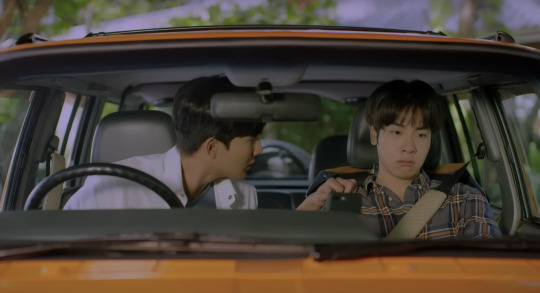
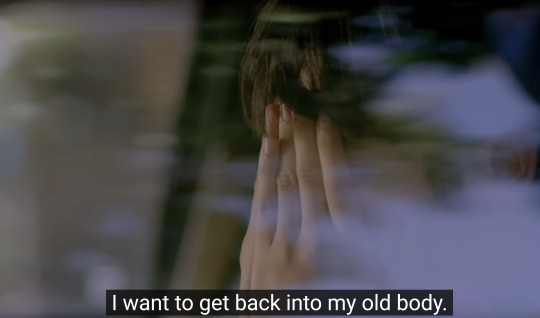
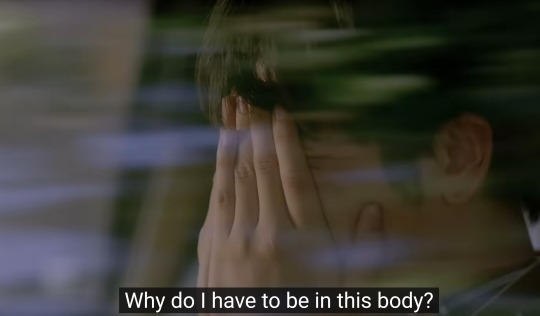
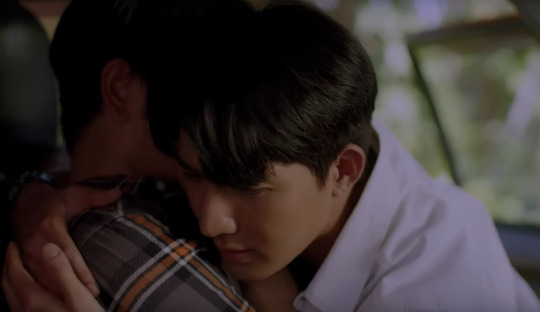
Not only did Korn exhibit the highest level of emotional intelligence every second of that show, in this specific moment, he stopped the vehicle, asked Win what was wrong, and actually took in what Win was saying without dismissing it. Then, he got out of the car, went around to hug Win properly, apologized, and waited until Win hugged him back.
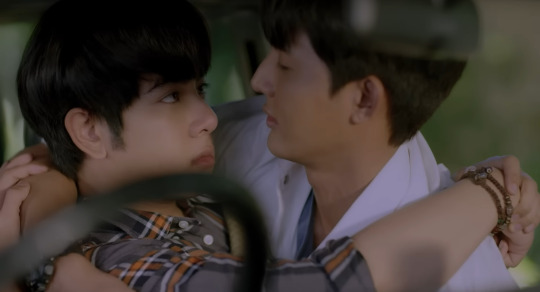
I have my grudges against this show (THAT DAMN MOTHER!!!!!), but Korn was the greenest of all green flags and the way he handled his future boyfriend's period should be held up as the standard.
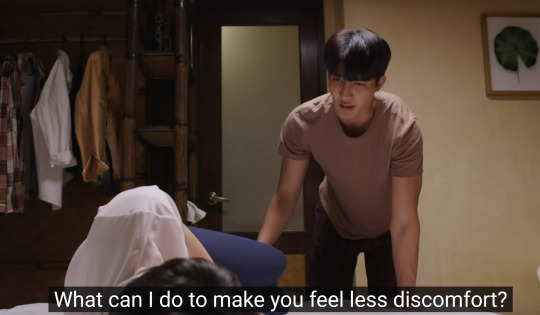
But one of the writers of the show was Pong who also wrote the screenplay for Cooking Crush and Only Boo! which are two shows I think epitomize care and comfort between partners.
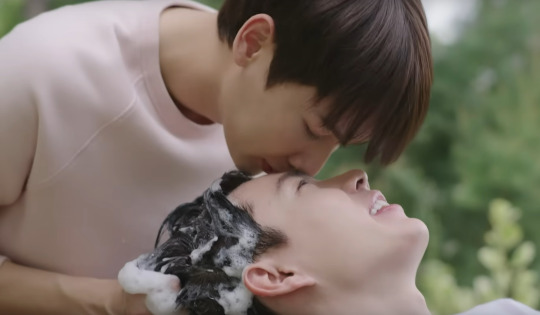
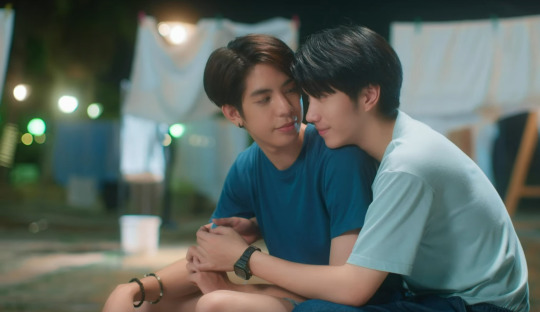
So now that I've gone on a tangent about partners actively taking care of each other, I hope you are enjoying seeing your flowers growing and not stressing too much over things beyond your control. I also want to let you know that I thought of you when I realized Domundi played me and instead of giving me a Pink Person in Your Sky, gave me a Yellow Yal, so I'm getting another Blue x Yellow pair.
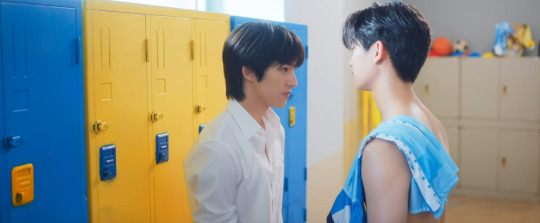
But for some *reason*, I'm less petty about it.
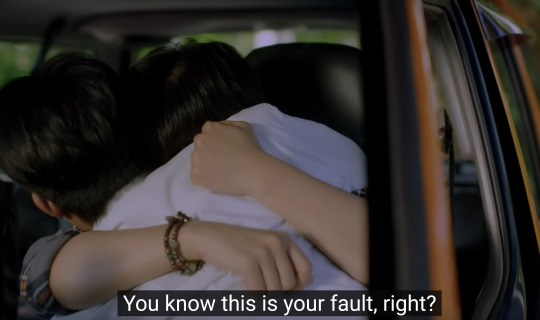
I hope you find comfort in that. 💙💛
#I see you played fair this time around#and didn't bring out any last minute shenanigans#so it's good that you can't have tags in an ask!#but now I'm going to rewatch the fourth and fifth episode of Cupid's Last Wish#and that's your fault too daddy
37 notes
·
View notes
Text
In 2017, soon after Google researchers invented a new kind of neural network called a transformer, a young OpenAI engineer named Alec Radford began experimenting with it. What made the transformer architecture different from that of existing A.I. systems was that it could ingest and make connections among larger volumes of text, and Radford decided to train his model on a database of seven thousand unpublished English-language books—romance, adventure, speculative tales, the full range of human fantasy and invention. Then, instead of asking the network to translate text, as Google’s researchers had done, he prompted it to predict the most probable next word in a sentence.
The machine responded: one word, then another, and another—each new term inferred from the patterns buried in those seven thousand books. Radford hadn’t given it rules of grammar or a copy of Strunk and White. He had simply fed it stories. And, from them, the machine appeared to learn how to write on its own. It felt like a magic trick: Radford flipped the switch, and something came from nothing.
His experiments laid the groundwork for ChatGPT, released in 2022. Even now, long after that first jolt, text generation can still provoke a sense of uncanniness. Ask ChatGPT to tell a joke or write a screenplay, and what it returns—rarely good, but reliably recognizable—is a sort of statistical curve fit to the vast corpus it was trained on, every sentence containing traces of the human experience encoded in that data.
When I’m drafting an e-mail and type, “Hey, thanks so much for,” then pause, and the program suggests “taking,” then “the,” then “time,” I’ve become newly aware of which of my thoughts diverge from the pattern and which conform to it. My messages are now shadowed by the general imagination of others. Many of whom, it seems, want to thank someone for taking . . . the . . . time.
That Radford’s breakthrough happened at OpenAI was no accident. The organization had been founded, in 2015, as a nonprofit “Manhattan Project for A.I.,” with early funding from Elon Musk and leadership from Sam Altman, who soon became its public face. Through a partnership with Microsoft, Altman secured access to powerful computing infrastructures. But, by 2017, the lab was still searching for a signature achievement. On another track, OpenAI researchers were teaching a T-shaped virtual robot to backflip: the bot would attempt random movements, and human observers would vote on which resembled a flip. With each round of feedback, it improved—minimally, but measurably. The company also had a distinctive ethos. Its leaders spoke about the existential threat of artificial general intelligence—the moment, vaguely defined, when machines would surpass human intelligence—while pursuing it relentlessly. The idea seemed to be that A.I. was potentially so threatening that it was essential to build a good A.I. faster than anyone else could build a bad one.
Even Microsoft’s resources weren’t limitless; chips and processing power devoted to one project couldn’t be used for another. In the aftermath of Radford’s breakthrough, OpenAI’s leadership—especially the genial Altman and his co-founder and chief scientist, the faintly shamanistic Ilya Sutskever—made a series of pivotal decisions. They would concentrate on language models rather than, say, back-flipping robots. Since existing neural networks already seemed capable of extracting patterns from data, the team chose not to focus on network design but instead to amass as much training data as possible. They moved beyond Radford’s cache of unpublished books and into a morass of YouTube transcripts and message-board chatter—language scraped from the internet in a generalized trawl.
That approach to deep learning required more computing power, which meant more money, putting strain on the original nonprofit model. But it worked. GPT-2 was released in 2019, an epochal event in the A.I. world, followed by the more consumer-oriented ChatGPT in 2022, which made a similar impression on the general public. User numbers surged, as did a sense of mystical momentum. At an off-site retreat near Yosemite, Sutskever reportedly set fire to an effigy representing unaligned artificial intelligence; at another retreat, he led colleagues in a chant: “Feel the AGI. Feel the AGI.”
In the prickly “Empire of AI: Dreams and Nightmares in Sam Altman’s OpenAI” (Penguin Press), Karen Hao tracks the fallout from the GPT breakthroughs across OpenAI’s rivals—Google, Meta, Anthropic, Baidu—and argues that each company, in its own way, mirrored Altman’s choices. The OpenAI model of scale at all costs became the industry’s default. Hao’s book is at once admirably detailed and one long pointed finger. “It was specifically OpenAI, with its billionaire origins, unique ideological bent, and Altman’s singular drive, network, and fundraising talent, that created a ripe combination for its particular vision to emerge and take over,” she writes. “Everything OpenAI did was the opposite of inevitable; the explosive global costs of its massive deep learning models, and the perilous race it sparked across the industry to scale such models to planetary limits, could only have ever arisen from the one place it actually did.” We have been, in other words, seduced—lulled by the spooky, high-minded rhetoric of existential risk. The story of A.I.’s evolution over the past decade, in Hao’s telling, is not really about the date of machine takeover or the degree of human control over the technology—the terms of the A.G.I. debate. Instead, it’s a corporate story about how we ended up with the version of A.I. we’ve got.
The “original sin” of this arm of technology, Hao writes, lay in a decision by a Dartmouth mathematician named John McCarthy, in 1955, to coin the phrase “artificial intelligence” in the first place. “The term lends itself to casual anthropomorphizing and breathless exaggerations about the technology’s capabilities,” she observes. As evidence, she points to Frank Rosenblatt, a Cornell professor who, in the late fifties, devised a system that could distinguish between cards with a small square on the right versus the left. Rosenblatt promoted it as brain-like—on its way to sentience and self-replication—and these claims were picked up and broadcast by the New York Times. But a broader cultural hesitancy about the technology’s implications meant that, once OpenAI made its breakthrough, Altman—its C.E.O.—came to be seen not only as a fiduciary steward but also as an ethical one. The background question that began to bubble up around the Valley, Keach Hagey writes in “The Optimist: Sam Altman, OpenAI, and the Race to Invent the Future” (Norton), “first whispered, then murmured, then popping up in elaborate online essays from the company’s defectors: Can we trust this person to lead us to AGI?”
Within the world of tech founders, Altman might have seemed a pretty trustworthy candidate. He emerged from his twenties not just very influential and very rich (which isn’t unusual in Silicon Valley) but with his moral reputation basically intact (which is). Reared in a St. Louis suburb in a Reform Jewish household, the eldest of four children of a real-estate developer and a dermatologist, he had been identified early on as a kind of polymathic whiz kid at John Burroughs, a local prep school. “His personality kind of reminded me of Malcolm Gladwell,” the school’s head, Andy Abbott, tells Hagey. “He can talk about anything and it’s really interesting”—computers, politics, Faulkner, human rights.
Altman came out as gay at sixteen. At Stanford, according to Hagey, whose biography is more conventional than Hao’s but is quite compelling, he launched a student campaign in support of gay marriage and briefly entertained the possibility of taking it national. At an entrepreneur fair during his sophomore year, in 2005, the physically slight Altman stood on a table, flipped open his phone, declared that geolocation was the future, and invited anyone interested to join him. Soon, he dropped out and was running a company called Loopt. Abbott remembered the moment he heard that his former student was going into tech. “Oh, don’t go in that direction, Sam,” he said. “You’re so personable!”
Personability plays in Silicon Valley, too. Loopt was a modest success, but Altman made an impression. “He probably weighed a hundred and ten pounds soaking wet, and he’s surrounded by all these middle-aged adults that are just taking in his gospel,” an executive who encountered him at the time tells Hagey. “Anyone who came across him at the time wished they had some of what he had.”
By his late twenties, Altman had parlayed his Loopt millions into a series of successful startup investments and become the president of Y Combinator, the tech mega-incubator that has spun off dozens of billion-dollar companies. The role made him a first point of contact for Valley elders curious about what was coming next. From Jeff Bezos, he borrowed the habit of introducing two people by e-mail with a single question mark; from Paul Graham, Y Combinator’s co-founder, he absorbed the idea that startups should “add a zero”—always think bigger. It was as if he were running an internal algorithm trained on the corpus of Silicon Valley-founder lore, predicting the next most likely move.
To the elders he studied, Altman was something like the tech world’s radiant child, both its promise and its mascot. Peter Thiel once remarked that Altman was “just at the absolute epicenter, maybe not of Silicon Valley, but of the Silicon Valley zeitgeist.” (Altman is now married to a young Australian techie he met in Thiel’s hot tub.) Graham offered his own version: “You could parachute him into an island full of cannibals and come back in five years and he’d be king.” Some kind of generational arbitrage seemed to be under way. In 2008, Altman began attending Sun Valley Conference, an exclusive annual retreat for industry leaders, where he eventually became “close friends,” we learn, with Barry Diller and Diane von Furstenberg. Yet, in the mid-twenty-tens, he still shared an apartment with his two brothers. Hao records a later incident in which he offered ketamine to an employee he’d just fired. He was both the iconic child to the tech world’s adults and the iconic adult to its children.
An interesting artifact of the past decade in American life is that the apocalyptic sensibility that came to grip U.S. politics during the 2016 Presidential campaign—the conviction, on both right and left, that the existing structure simply could not hold—had already bubbled up in Silicon Valley a few years earlier. By 2015, Altman had been donating to Democratic candidates and seemed to have seriously considered a run for governor of California. But he also told Tad Friend, in a New Yorker Profile, that he was preparing for civilizational collapse and had stockpiled “guns, gold, potassium iodide, antibiotics, batteries, water, gas masks from the Israeli Defense Force, and a big patch of land in Big Sur I can fly to.”
One view is that tech billionaires saw the brink early because they understood just how unequal—and therefore unstable—American society was becoming. But, inside the Valley, that anxiety often expressed itself in the language of existential risk. In particular, fears about runaway artificial intelligence surged around the time of the 2014 publication of “Superintelligence,” by the philosopher Nick Bostrom. According to Hao, Elon Musk became fixated on an A.I. technologist, Demis Hassabis—a co-founder of DeepMind, which had recently been acquired by Google—whom Musk reportedly viewed as a “supervillain.” That same year, at an M.I.T. symposium, Musk warned that experiments in artificial intelligence risked “summoning the demon.”
Altman had been itching for a bigger project. The next Memorial Day weekend, he gathered hundreds of young Y Combinator protégés for an annual glamping retreat among the redwoods of Mendocino County. The night before, he had beaten a group of Y Combinator staffers at Settlers of Catan. Now, standing before them, he announced that his interests had narrowed—from, roughly, all of technology to three subjects that he believed could fundamentally change humanity: nuclear energy, pandemics, and, most profound of all, machine superintelligence.
That same month, Altman sent an e-mail to Musk. “Been thinking a lot about whether it’s possible to stop humanity from developing AI,” he wrote. “I think the answer is almost definitely not. If it’s going to happen anyway, it seems like it would be good for someone other than Google to do it first.” Altman proposed his Manhattan Project for A.I. so that the technology, as he put it, would “belong to the world,” through some form of nonprofit. Musk replied, “probably worth a conversation.”
It fell to Chuck Schumer, of all people, to offer the secular-liberal benediction for the project—by then consolidated as OpenAI and led by Altman, who had sidelined Musk. “You’re doing important work,” the New York senator told the company’s employees, seated near a TV projecting a fire, during an off-the-record visit to OpenAI’s headquarters in 2019, as Hao documents. “We don’t fully understand it, but it’s important.” Schumer went on, “And I know Sam. You’re in good hands.”
How do people working in A.I. view the technology? The standard account, one that Hao follows, divides them into two camps: the boomers, who are optimistic about AI’s potential benefits for humanity and want to accelerate its development, and the doomers, who emphasize existential risk and edge toward paranoia. OpenAI, in its original conception, was partially a doomer project. Musk’s particular fear about Demis Hassabis was that, if Google assigned a potential A.G.I. the goal of maximizing profits, it might try to take out its competitors at any cost. OpenAI was meant to explore this technological frontier in order to keep it out of malign hands.
But in early 2018 Musk left. The organization was struggling to raise funds—he had pledged to raise a billion dollars but ultimately contributed less than forty-five million—and a faction within OpenAI was pushing to convert it to a for-profit entity, both to attract capital and to lure top researchers with equity. At the meeting where Musk announced his departure, he gave contradictory explanations: OpenAI, he said, wouldn’t be able to build an A.G.I. as a nonprofit, and that Tesla had more resources to pursue this goal, but he also suggested that the best place to pursue A.G.I. was elsewhere. An intern pointed out that Musk had insisted that the for-profit dynamic would undermine safety in developing A.G.I. “Isn’t this going back to what you said you didn’t want to do?” he asked. “You can’t imagine how much time I’ve spent thinking about this,” Musk replied. “I’m truly scared about this issue.” He also called the intern a jackass.
As OpenAI evolved into a nonprofit with a for-profit subsidiary, it came to house both perspectives: a doomer group focussed on safety and research, whose principal advocate was the Italian American scientist Dario Amodei; and a boomer culture focussed on products and applications, often led by Greg Brockman, an M.I.T. dropout and software engineer who pushed the organization toward embracing commercialization. But these lines crossed. Amodei ultimately left the company, alongside his sister, Daniela, insisting that OpenAI had abandoned its founding ethos, though, in Hao’s view, the company they founded, Anthropic, would “in time show little divergence” from OpenAI’s model: the same fixation on scale, the same culture of secrecy. From the other direction came Ilya Sutskever, who had made a major breakthrough in A.I. research as a graduate student in Toronto, and who would become perhaps OpenAI’s most influential theorist. He had once been an unabashed boomer. “I think that it’s fairly likely,” he told the A.I. journalist Cade Metz, “that it will not take too long of a time for the entire surface of the Earth to become covered with data centers and power stations.” By 2023, however, when he helped orchestrate a briefly successful corporate coup against Altman, he was firmly aligned with the doomers. The trajectories of Sutskever and the Amodeis suggest a more fluid category—the boomer-doomers.
Those who most believe in a cause and those who most fear it tend to share one essential assessment: they agree on its power. In this case, the prospect of a technology that could end a phase of civilization drew both camps—boomers and doomers—toward the same flame. Helen Toner, an A.I.-safety expert and academic who eventually joined OpenAI’s board, had spent time studying the fast-evolving A.I. scene in China, the United States’ chief rival in the global race. As Hagey recounts, “Among the things she found notable in China was how reluctant AI engineers were to discuss the social implications of what they were doing. In the Bay Area, meanwhile, they seemed to want to do nothing but.”
Yet OpenAI’s success hinged less on speculative philosophies than on more familiar systems: the flexibility of American capital, and Altman’s personal charm. In 2018, while attending the Sun Valley Conference, in Idaho, Altman ran into Microsoft’s C.E.O., Satya Nadella, in a stairwell and pitched him on a collaboration. Though Bill Gates was skeptical, most of Nadella’s team was enthusiastic. Within a year, Microsoft had announced an investment of a billion dollars in OpenAI—much of it in the form of credits on its cloud platform, Azure. That figure later rose beyond ten billion. Hao speaks with a Chinese A.I. researcher who puts it plainly: “In China, which rivals the U.S. in AI talent, no team of researchers and engineers, no matter how impressive, would get $1 billion, let alone ten times more, to develop a massively expensive technology without an articulated vision of exactly what it would look like and what it would be good for.”
Nadella appears only in passing in both of these books—he’s the adult in the room, and adults are famously not so interesting. But after Microsoft’s multibillion-dollar investments, his influence over OpenAI has come to appear at least as consequential as Altman’s. It was Nadella, after all, who intervened to end the brief 2023 coup, after which Altman was swiftly reinstalled as C.E.O. The year before, Sutskever remarked that “it may be that today’s neural networks are slightly conscious”—a comment to which a scientist at a rival A.I. company replied, “In the same sense that it may be that a large field of wheat is slightly pasta.” Nadella, by contrast, seems broadly allergic to boomer-doomer metaphysics.
The deeper dynamic of contemporary artificial intelligence may be that it reflects, rather than transcends, the corporate conditions of its creation—just as Altman mirrored the manners of his Silicon Valley elders, or as a chatbot’s replies reflect the texts it has been trained on. Appearing recently on Dwarkesh Patel’s influential tech podcast, Nadella, a smooth and upbeat presence, dismissed A.G.I. as a meaningless category. When Patel pressed him on whether A.I. agents would eventually take over not only manual labor but cognitive work, Nadella replied that this might be for the best: “Who said my life’s goal is to triage my e-mail, right? Let an A.I. agent triage my e-mail. But after having triaged my e-mail, give me a higher-level cognitive-labor task of, hey, these are the three drafts I really want you to review.” And if it took over that second thing? Nadella said, “There will be a third thing.”
Nadella seemed quite convinced that A.I. remains a normal technology, and his instinct was to try to narrow each question, so that he was debating project architecture rather than philosophy. When Patel wondered if Nadella would add an A.I. agent to Microsoft’s board, a fairly dystopian-sounding proposition, Nadella replied that Microsoft engineers were currently experimenting with an A.I. agent in Teams, to organize and redirect human team members, and said that he could see the use of having such an agent on Microsoft’s board. It did sound a bit less scary, and also maybe a bit less interesting.
Much like Altman, Nadella is now trying to shift the way the public thinks about A.I. by changing the way it’s talked about—less science fiction, more office productivity. It’s an uphill fight, and at least partly the industry’s own fault. The early, very public bouts of boomerism and doomerism helped attract investment and engineering talent, but they also seeded a broad, low-level unease. If Sutskever—who knew as much about the technology as anyone—could declare it “slightly conscious,” it becomes markedly harder for Nadella, three years later, to reassure the public that what we’re really talking about is just helpful new features in Microsoft Teams.
In other ways, too, Altman is contending with a shifting cultural tide. Sometime around 2016, the tone of tech coverage began to darken. The hagiographic mode gave way to a more prosecutorial one. David Kirkpatrick’s “The Facebook Effect” (2010) has its successor in Sarah Wynn-Williams’s “Careless People” (2025); Michael Lewis’s “The New New Thing” (1999) has been countered by Emily Chang’s “Brotopia” (2018); even Amazon’s great chronicler, Brad Stone, moved from “The Everything Store” (2013) to the more skeptical “Amazon Unbound” (2021).
Hao’s reporting inside OpenAI is exceptional, and she’s persuasive in her argument that the public should focus less on A.I.’s putative “sentience” and more on its implications for labor and the environment. Still, her case against Altman can feel both very personal and slightly overheated. Toward the end of “Empire of AI,” she writes that he has “a long history of dishonesty, power grabbing, and self-serving tactics.” (Welcome to the human race, Sam.) Hao tries hard, if not very successfully, to bolster an accusation made public in 2021 by his sister Annie Altman—that, beginning when she was three and Sam was twelve, he climbed into her bed and molested her, buried memories that she says she recovered during therapy in her twenties. (Altman denies the allegation.) This new, more critical vision of the tech founders risks echoing Musk’s vendetta against Hassabis—inflating contingent figures into supervillains, out of ambient anxiety.
Altman’s story is at once about a man changing artificial intelligence and about how A.I.’s evolving nature has, in turn, changed him—quieting, without resolving, the largest questions about work, power, and the future. Hao’s book opens in late 2023, with the brief ouster of Altman by Sutskever and several senior OpenAI executives, an episode now referred to internally as “the Blip.” When Altman learns of the attempted coup, he is in Las Vegas for a Formula 1 race. Sutskever calls him over Google Meet and tells him that he is being fired. Altman remains serene. He doesn’t appear to take the moment too seriously—perhaps because, in Sutskever’s zeal, he recognizes a version of his former self. Calmly, he replies, “How can I help?” He has become, in every sense, all business.
3 notes
·
View notes
Note
specifically the screenplay i can find online mentions a scene of lawrence opening his umbrella and the cardinals following him before the top-down shot, and that's not in the movie to the best of my recollection, so who else would be symbolic enough that such a change was made from the screenplay to the filming? tedesco and benitez are the only two significant enough at this point of the movie, and they have way too much hair, it's clearly not them. plus it makes sense that a scene with lawrence leading the cardinals be replaced by a scene where he stands out in their crowd, both are focused on him, and i don't think they would've wanted to give lawrence's place less focus here. his balding pattern is one less layer for god to go through i guess.
sorry, i saw your tags and i wanted to corroborate evidence to my claim, good exercise for the mind.
Hello!! No pls don't apologize, I'm all about talking about Conclave <3
You're right about the hair lmao! So it definitely wasn't Tedesco and Benitez. But they placed him somewhere subtle that I also only noticed it when I watched it for the 2nd time. Kinda interesting! (If i remember it correctly he was walking on the left side of the crowd pls correct me if im wrong) Why there? Why not the middle? 🤔
Maybe it was a mistake (unlikely because the conclave crew's attention to detail is KRAZY) and i remembered there was some deleted scenes in the movie (I think this is where Bellini and Lawrence walks together, not sure though, i saw some screenshots of the screenplay in twitter).
Hopefully they'll release the deleted scenes 🙏
6 notes
·
View notes
Note
oh my gosh, the matchmaking service seems so cool!! could i be paired with one of the older teens please? any gender is fine :)
so, my name is beth. my personality type is infj and i feel as if i fit it incredibly well. i’m autistic and physically disabled (ileostomy) and my special interest is fleetwood mac. i love soft rock of the 70s and 80s, like dire straits and billy joel, as well as some harder stuff like def leppard and ac/dc.
i’m kind of a hippie in fashion and partially in thought. i’m always wearing long patterned flowy skirts and my favourite cream knitted cardigan. i currently study film and love to write, whether that be fiction stories or a screenplay. i am a deep thinker and love to reflect on life around me, making me interested in philosophy and psychology, which influences my film work a lot. that mindset also means i journal when i can, and find it quite therapeutic to jot down my thoughts in relation to the prompts i find. i love figuring out the reasons for being the way i am.
i also play guitar and sing. i love fingerpicking and i’m always playing ‘landslide’ and ‘blackbird.’ i also own a bunch of records and am an avid jewellery collector. i love showing off my style through that.
going back to my personality type, i’m quite slow to warm up to. i don’t like small talk and would rather jump into deep conversations about life. however, i am an introvert and can usually only stay at places for around 6 hours at a time. you have to be very special to me if i can survive longer than that. but, when i am close with someone, i am a very big yapper. about anything. sometimes i struggle to stop. i am also very organised and love to keep to-do lists to keep myself on track. it makes my brain calm.
i think that is everything! sorry if i rambled! can’t wait to see who i get matched with :)
Beth, my love, I want to be friends we are literally like the same person 🥹

I think Gareth is head over heels for you lovely! He loves that having you next to him is like a little opposites attract thing. He likes to think he’s hard and cold, but you’re warm and soft and so so so so beautiful (he could literally talk about that all day.
I think Gareth’s attention span is not the greatest, but he will try and watch so many movies with you so you can study them, giving his ‘expert opinion’ on the soundtrack.
He loves to hear you yap. It’s his favorite sound in the whole universe. In fact, he begs you to record some lines to put in Corroded Coffins new album !
He’s wearing your jewelry, sorry, I don’t make the rules. That little ring he wears? That necklace? You got him those. 100%
3 notes
·
View notes
Text
i know i'm very late to the party, but i watched "baby reindeer" incrementally over the past week. i liked it a lot, but IMO they really dropped the ball on teri's dialogue. it's just horrible at times.
this character is supposed to be a therapist and the protagonist describes her as intelligent. that said, half of her lines sound like they were ripped from meme-y instagram self help accounts. she says something to the effect of, "i'm here with my friends so i can break my pattern of going back to toxic men". who talks like that irl? honestly? if you want to characterize someone in your screenplay as smart, it's helpful to give them original thoughts. or original sounding thoughts, at the very least.
i was very frustrated with that part about it. she seems dumber than a box of rocks when that obviously wasn't the intention. oof.
7 notes
·
View notes
Text

TCM Disability Week, Day 7: Headcanon.
@texas-chainsaw-fanworks
Artist's statement + rambling + a transcript of the text below.
Text : "Enright seems unphased by most of what's going on. He's slugging down the Mezcal- sweating. Enright's eyes shake in his own private nightmare. He sees chainsaws all around him: splintering the walls; hacking up through the floor; shattering the furniture. The chainsaws' rampage goes on and on insanely. Enright doesn't flinch. "
I recently got my hands on a copy of the TCM 2 original screenplay, which has a lot more characterization for Lefty. The passage above is an expert from the screenplay which kind of plays into my headcanon. I'm not sure it's 100% a headcanon bc of the original screenplay but I'm still counting it. I think Lefty suffers from alcoholism (or like. More properly SUD) and psychosis caused by some kind of underlying condition. In my mind it's PTSD with psychotic features since his symptoms seem to relate to/ revolve around the sudden traumatic loss he experienced (hallucinations of their weaponry, paranoia about the killers' awareness of him/ ability to find him. And in my reading of the og script he and Sally both show a lot of dissociative symptoms, which is common with PTSD, especially severe PTSD, which co-occurs most commonly with PTSD with psychotic features.) I find Lefty's particularly psychology interesting because hes one of very few tcm characters who shows a lot of symptoms of mental illness on screen without being an outright villain.
I tried to portray all that by painting his expression in the scene the text is from, and dripping it all with melted crayon, which both creates a blood spatter- like pattern, but also, like the script text which is on a separate piece of paper, creates another dimension/ layer of the paper that exists on a different plane from Lefty himself. Something he might feel and might perceive, but is on a different plane from himself.
#tcm#lefty enright#tcmfanevent#tcmdisabilityweek#i think leftys whole deal matters to me#both bc i 1. latched onto him for silly reasons#and 2. just like... see a lot of my symptoms in him?#idk how open i really want to get on my silly little tcm blog but like#ive been in treatment of some kind for over a decade now. tried every sort of medication they've been willing to give me#but i still have those moments of being like. locked in my own unpercievable hell#waiting for it to end. not outwardly bothered by it anymore. just... goin through it#wrow that got dark#in good news ill probably get to start a new (kind of experimental?) medicaiton/ treatment ordeal they think might be helpful for someone#with my whole deal#and like my stuff is way better now than it used to be. i used to fit the critera for like 6 or 7 different diagnoses. now its like 4 or so#anyways all that to say its a hell of a fight sometimes but it does get better 👍#even if youre also a kind of severe case like me
17 notes
·
View notes
Text
Porco Rosso

You know, I usually forget about Porco Rosso when thinking about my favorite Ghibli movies but it’s a banger.
After this rewatch, it’s hard for me to think of it as anything other than Miyazaki’s self-insert fanfic. Seriously, this is like his ideal world - everyone’s flying their personal planes around and parking them like they’re cars at the local diner, Porco’s this big cool guy who everyone respects and all the hot babes are into, and he gets to live alone with no one bothering him in a cool island cove. It’s even set in 40s Europe, so he has all his favorite fascist planes available*!
*oh yeah, you thought The Wind Rises was problematic? Let me introduce you to Studio Ghibli’s namesake and start unveiling the pattern here
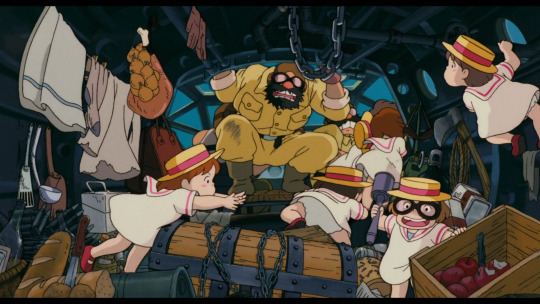
behold - the intractable chaotic force that is two dozen kidnapped schoolgirls
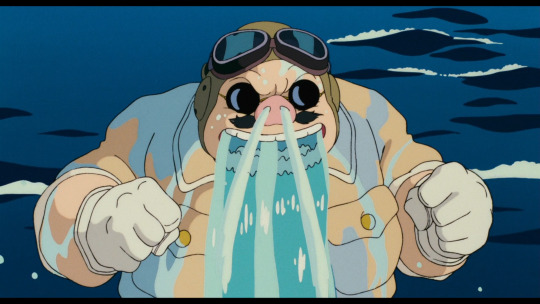
Anyway, I think the strongest point in Porco Rosso’s favor is that it’s just funny as fuck. I don’t know how the Japanese audio track is, but the dub is some king shit. I get that this is a ‘when you have a hammer everything looks like a nail’ situation, but honestly it has Big Redline Energy imo.
We’ve got your classic early 2000s gravelly-voiced Steve Blum-alike too-cool protagonist, contrasted with a world surrounding him that absolutely refuses to take itself seriously with constant dumb gags and throwaway jokes. The American guy provides a lot of this (I died at the raw fuckboy energy exuded from him saying “That’s my favorite line from a screenplay I wrote”), but it’s everywhere - the fuckin Carnival Cruise liner deploying their own personal fighter jets to fight off pirates, with color commentator already on deck and raring to go, was probably my favorite. Even the dogfights, which for the most part remain somewhat grounded and above board due to Miyazaki’s plane fetish, get real goofy at points, with Porco and Curtis throwing wrenches at each other like a cartoon.


I mean, come on! ehh? right? just me?

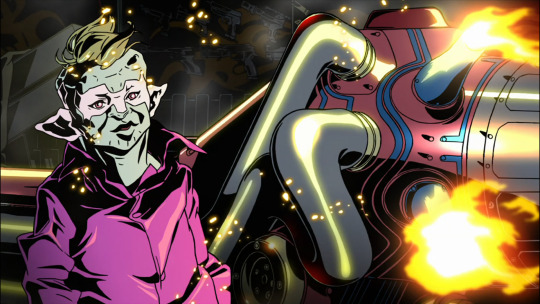
sidenote: while grabbing these caps it was interesting to see the contrasting approaches to showing the engine's power in each of these scenes. In Porco Rosso, they focus on the characters themselves and their elastic properties, showing Porco's ears and jowls flapping wildly in the wind, which leads to some great freezeframes. Frisby doesn’t have much in the way of loose body parts, so instead they focus on his loose shirt billowing with the force - it doesn't really translate as well in a still but looks great in motion.
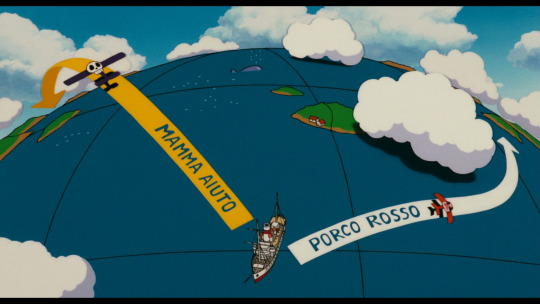
At the end of the day it has its issues - I’m still not convinced it’s just Porco that doesn’t take women seriously and not the movie itself - but it’s a damn good time.

11 notes
·
View notes
Text
poor things thoughts. okay yeah that would have worked far better as a miniseries primarily because the attempts at introducing key philosophical and political discourses fell flat due to the exceedingly short runtime that their exploration was confined to. it was also overly edgy and the themes of structural misogyny and medical ableism clashed with the comic whimsical tone (i know, i know that was the point — still left a sour taste in my mouth) . the jokes sometimes landed and othertimes just felt artificial and stitched-together like some frankenstein’s monster. the whole of the film felt unfinished and inconclusive that way, which, again, may have been the point… nevertheless.
lanthimos cannot write dialogue that sounds even remotely realistic. the stilted, theatrical, semi-literary turns of phrase, speech patterns and mannerisms work for bella because she’s autistic-coded (i speak sort of like her in real life) but it does not work for the characters that are intended to be read as somewhat socially well-adjusted. get yourself a screenplay editor
now to the good! the world which the designers have created is a visual and aesthetic masterpiece, an art-nouveau tour de force. i would like very much to live with that world, even with all its heavily stylised evils and vices. the trappings have trapped me. sucker for gothic sci-fi magical realism, what can i say! also, the score is fittingly discordant and unsettling. dance scene — flawless. bella baxter is a joy to behold.
not to sound like a “puriteen”. but a little less sex and a little more conversation wouldn’t have hurt anyone.
6.5/10. this review will be pasted to my letterboxd
22 notes
·
View notes